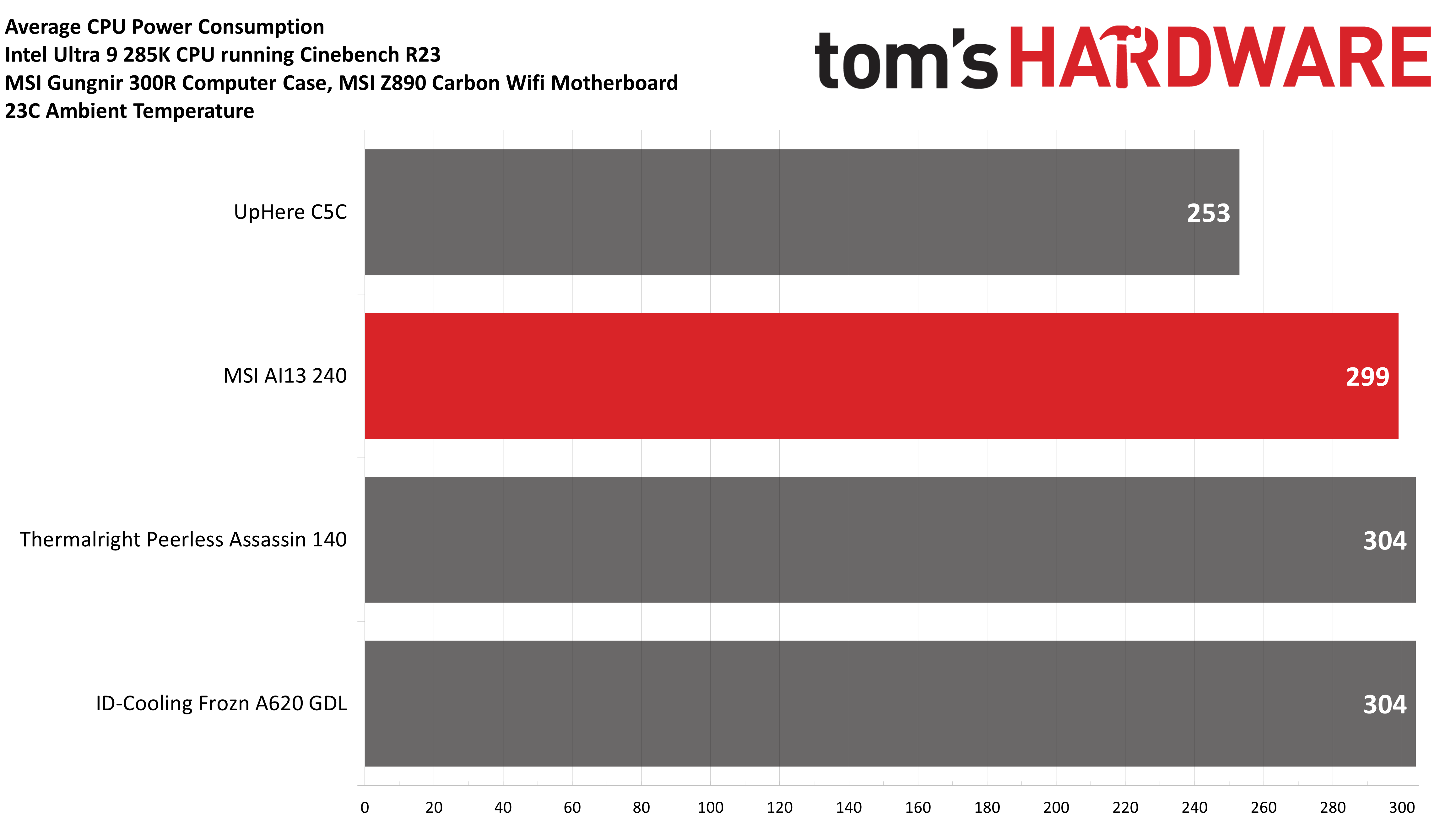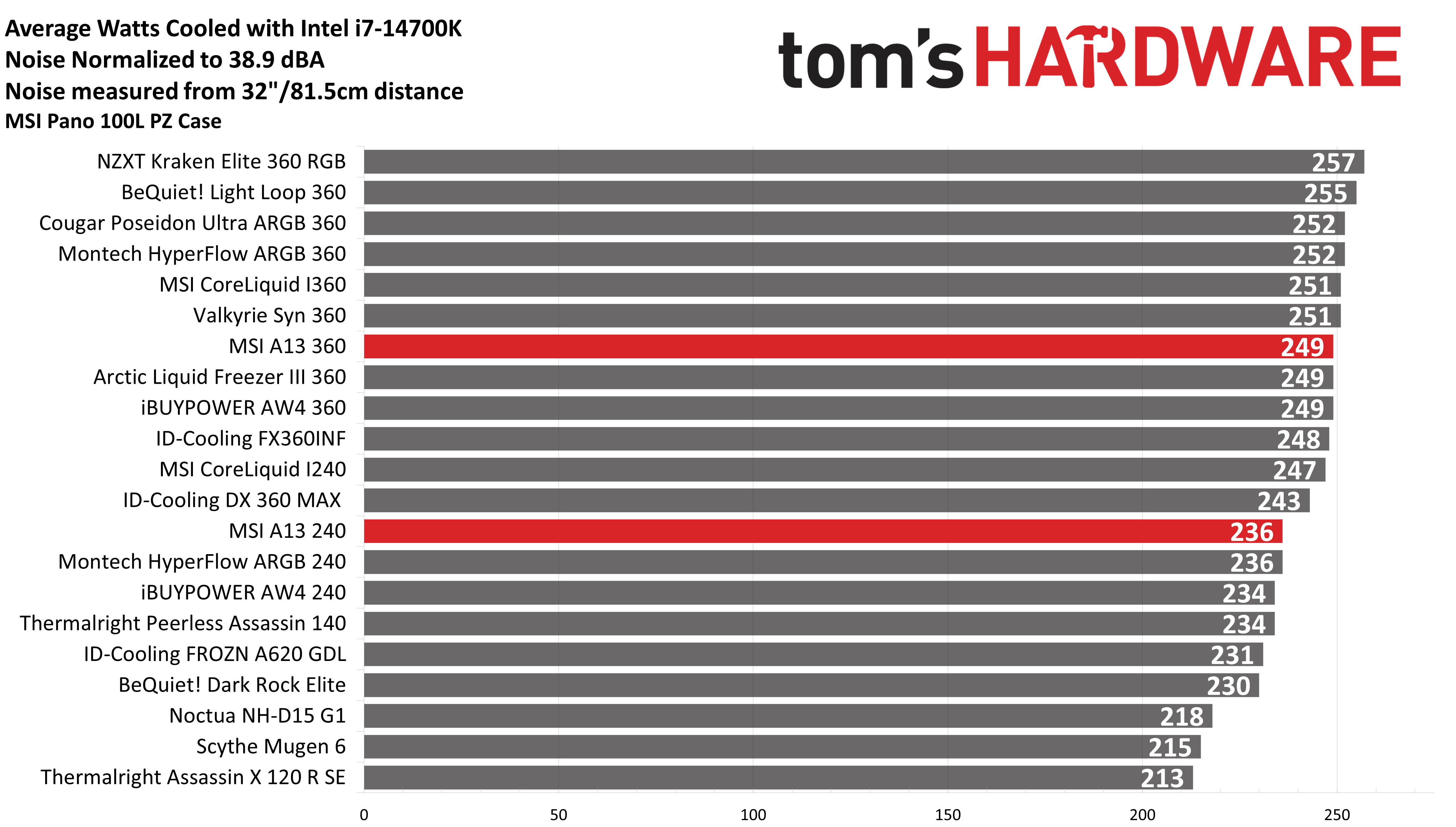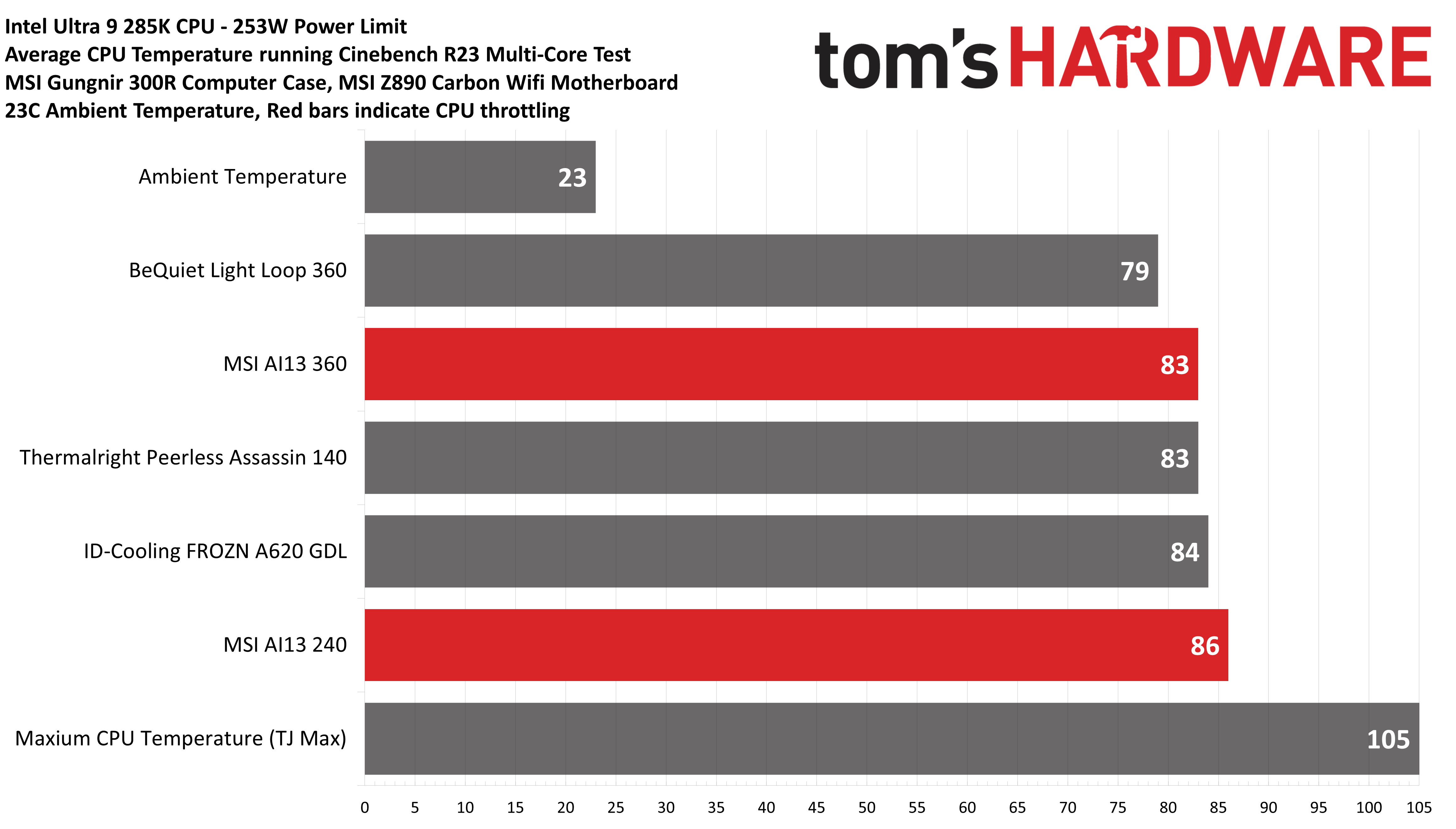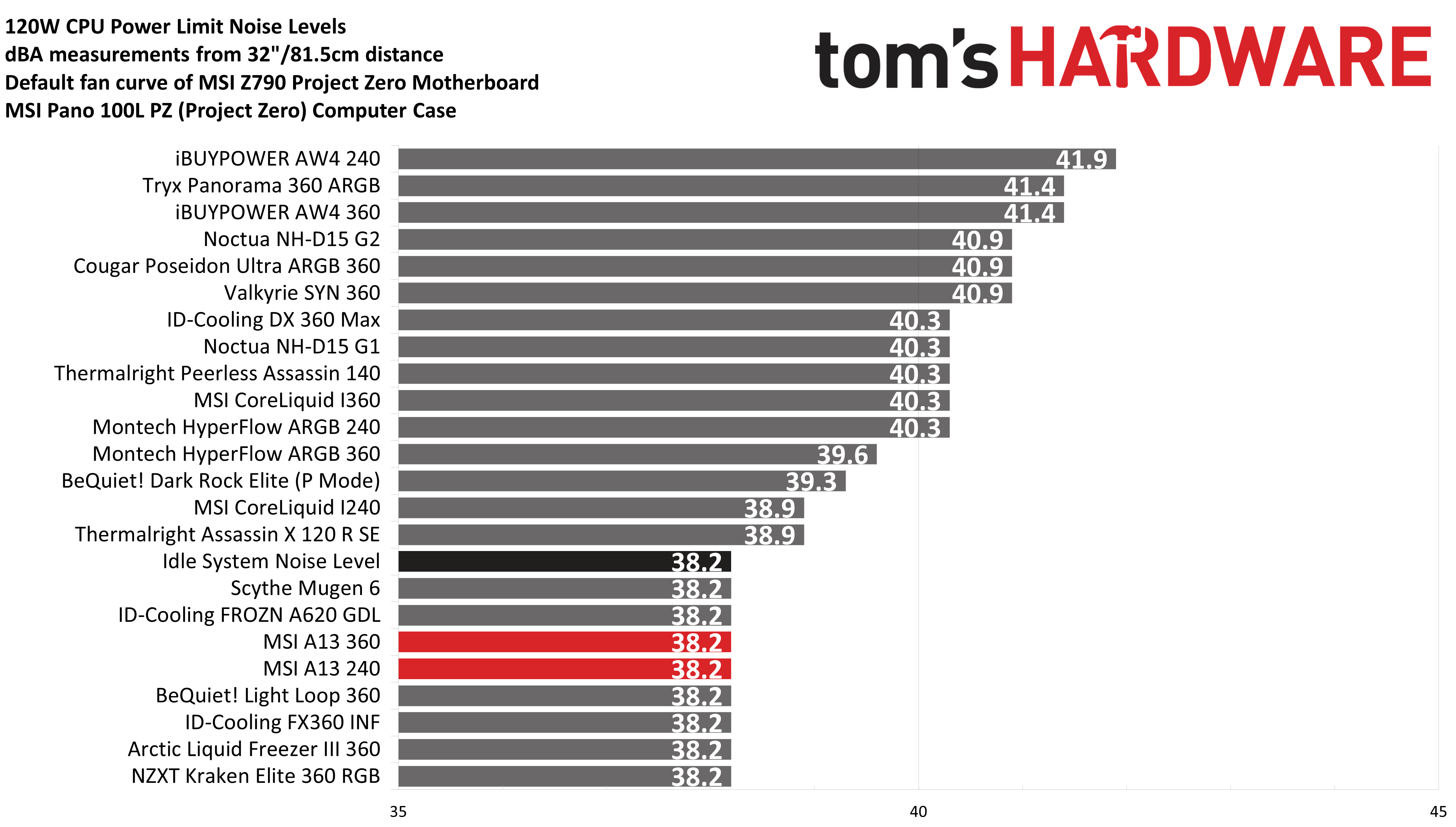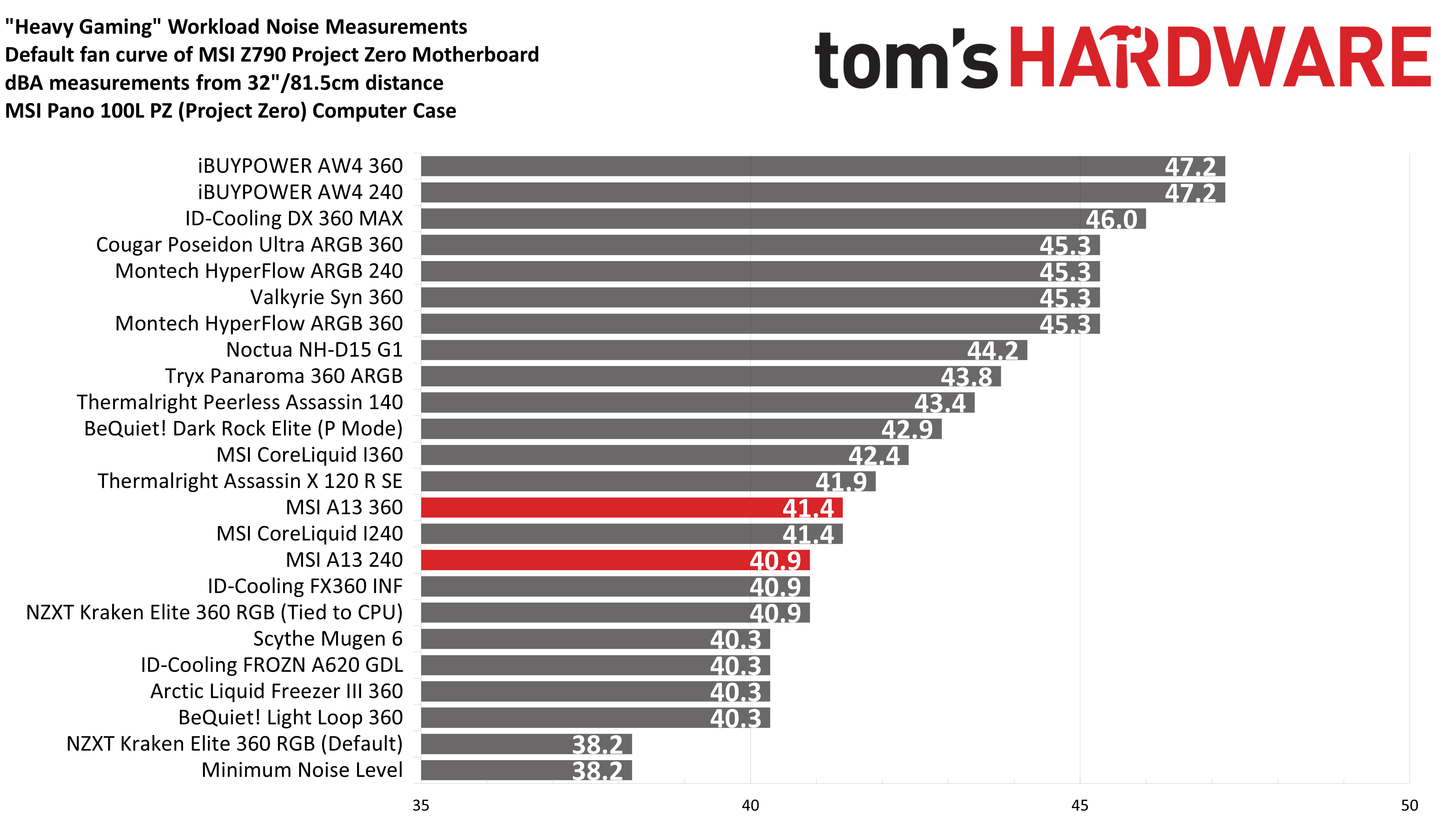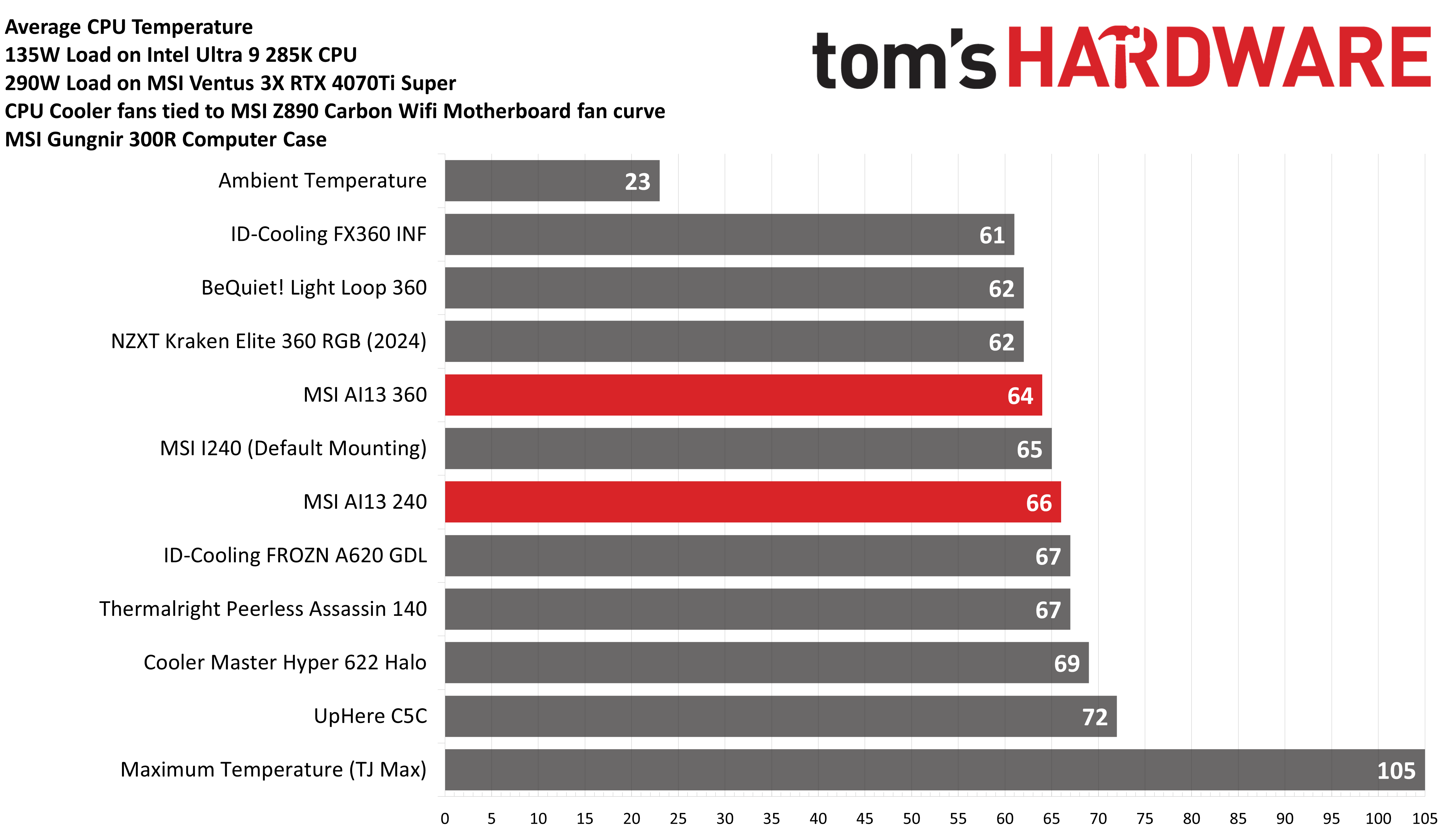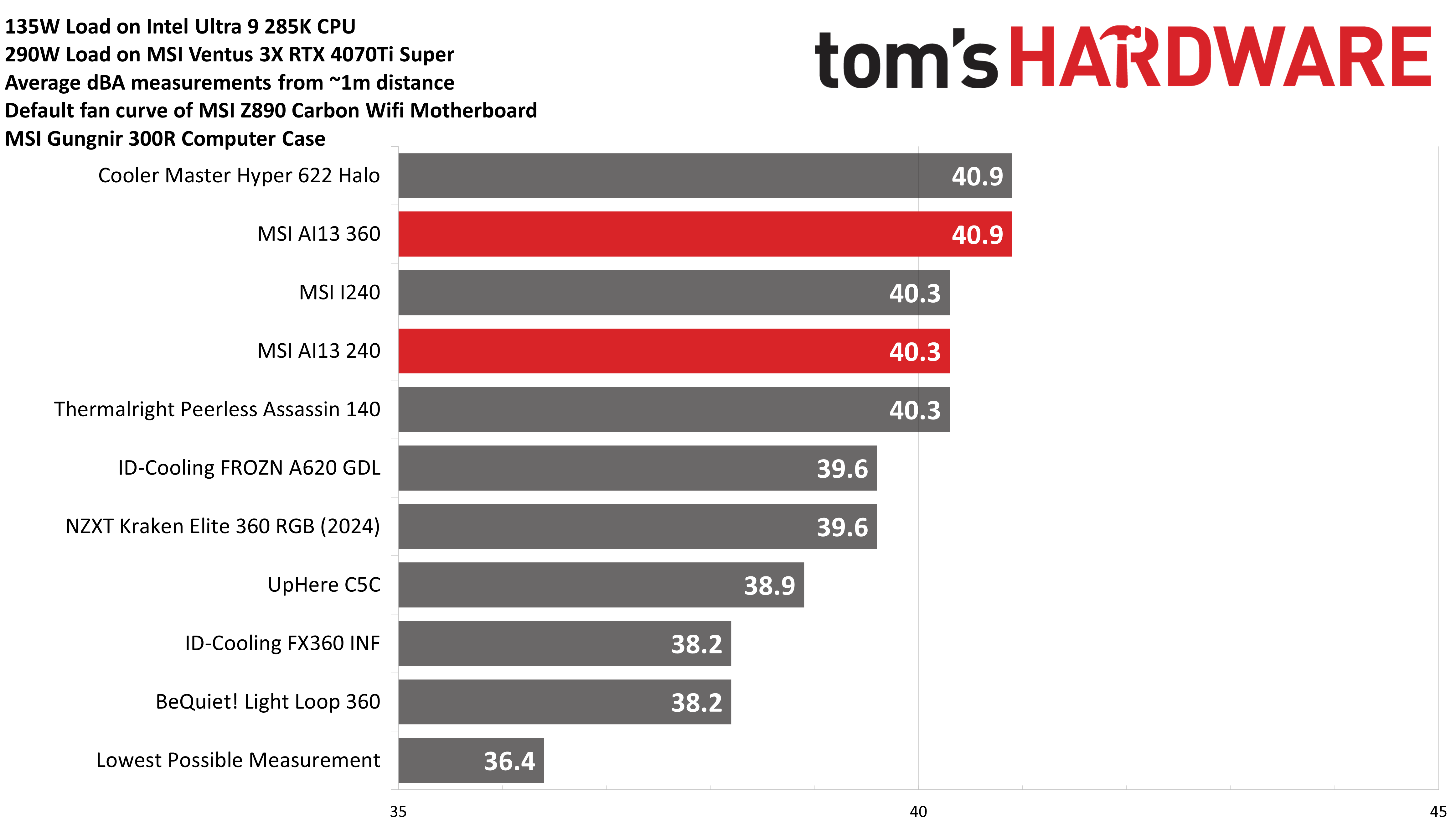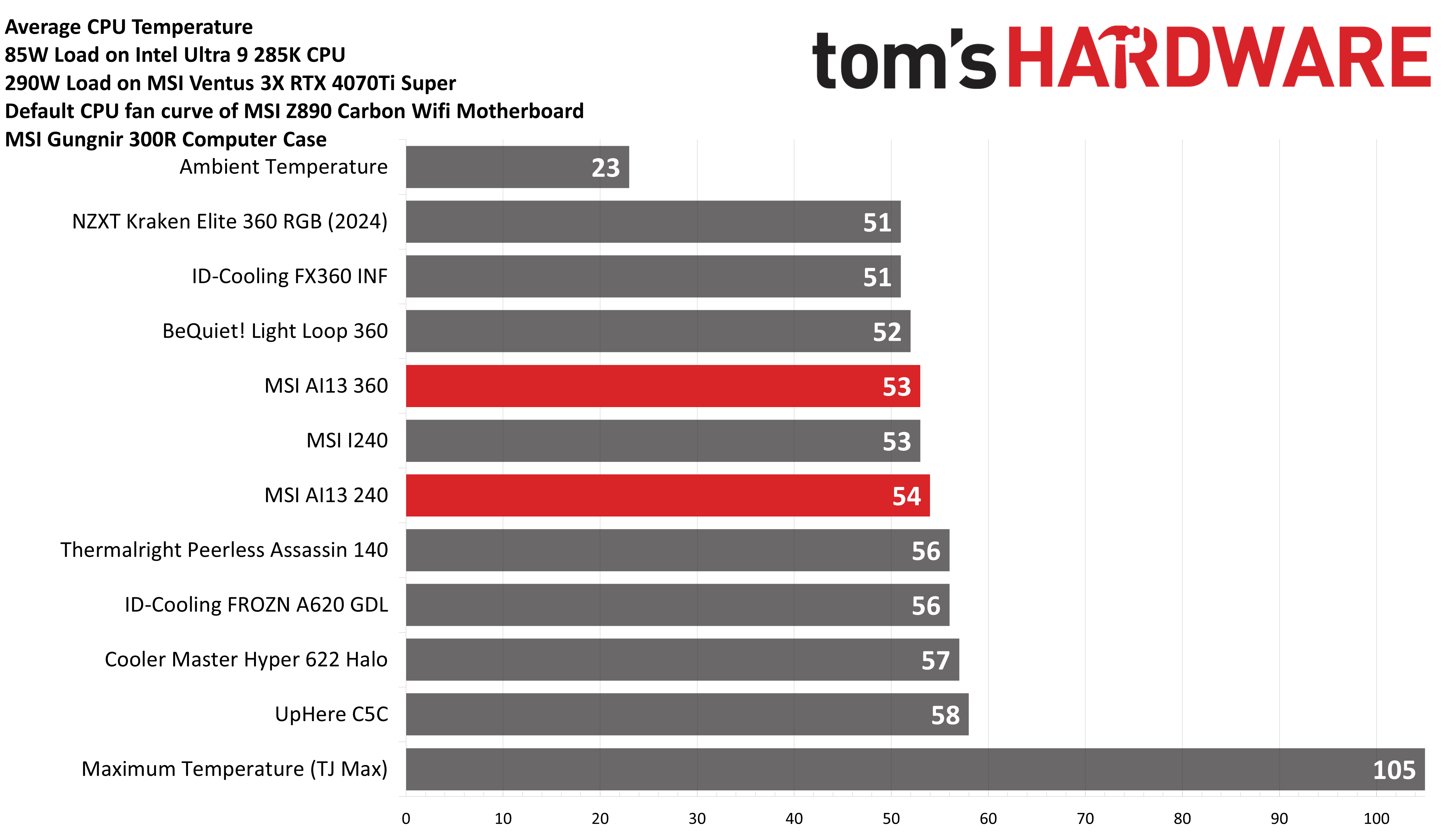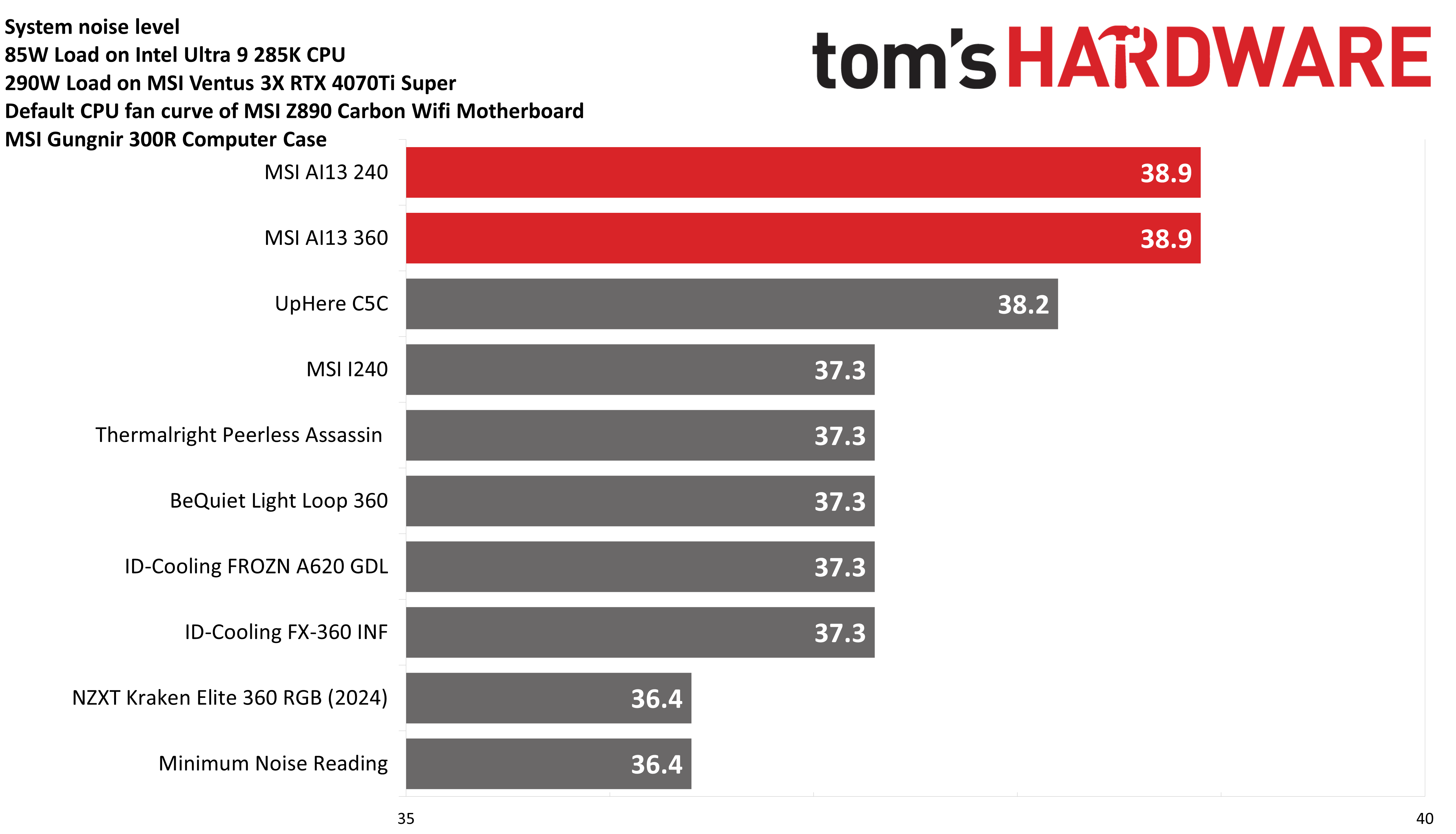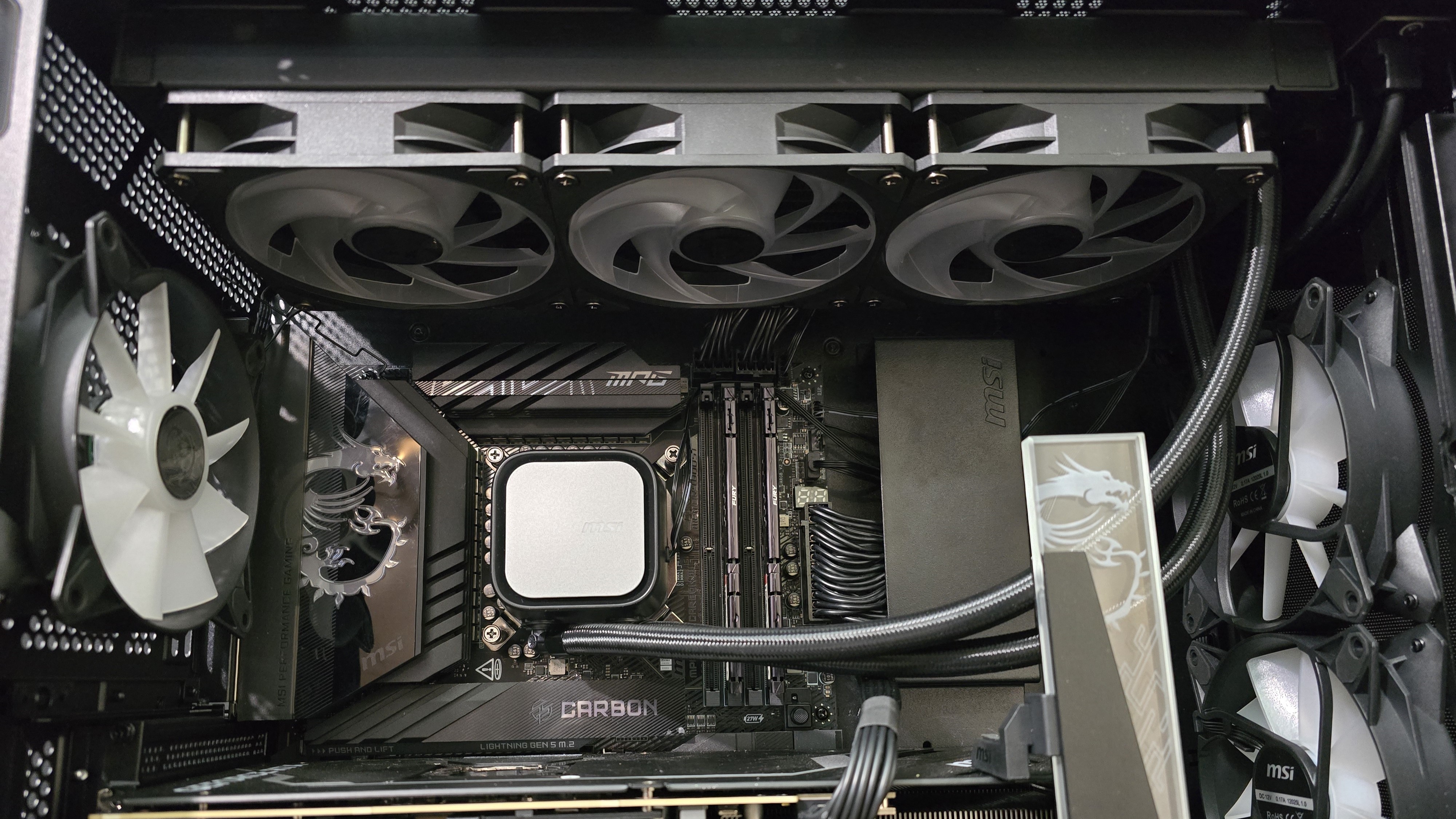Why you can trust Tom's Hardware
CPU-only thermal results without power limits
Without power limits enforced on Intel’s Core Ultra 9 285K and i7-14700K CPUs, the CPU will hit its peak temperature (TJ Max) and thermally throttle with even the strongest of air coolers and even most liquid coolers on the market. When the CPU reaches its peak temperature, I’ve measured the CPU package power to determine the maximum wattage cooled to best compare their performance.
It’s important to note that thermal performance can scale differently depending on the CPU it’s being tested with – which is one of the reasons I show results for maximum intensity scenarios with two different systems now.
With Intel’s i7-14700K, neither of MSI’s A13 AIOs can keep the CPU below its peak temperature – so we’ll look at the CPU package power instead. With this system, the 360mm version of the A13 performed just a hair ahead of competing coolers from Arctic and ID-Cooling, with 259W cooled during the course of testing.
The performance of the 240mm A13 wasn’t quite as impressive – performing only on par with the best air coolers, and slightly behind other 240mm units.
The results are a little different when testing with the “Arrow Lake” Core Ultra 9 285K. Some coolers will do better or worse on Arrow Lake due to its shifted hotspot, but overall the CPU’s cooling difficulty is lower than Raptor Lake CPUs like the i7-14700K or i9-14900K.
The 360mm version of the A13 performs better on Arrow Lake, keeping the CPU at an average of only 95 degrees C during this test of Cinebench without power limits.
The 240mm version of the A13 was not able to keep the CPU from reaching its peak temperature, so we’ll look at the CPU package power for this one. Honestly, it performed worse on Arrow Lake than I expected – falling a few watts behind the performance of good air coolers like Thermalright’s Peerless Assassin 140!
Get Tom's Hardware's best news and in-depth reviews, straight to your inbox.
CPU-only Thermal results with noise normalized to 38.9 dBA
Finding the right balance between fan noise levels and cooling performance is important. While running fans at full speed can improve cooling capacity to some extent, the benefits are limited and many users prefer a quieter system.
With this noise-normalized test, I’ve set noise levels to 38.9 dBA using the i7-14700K system. This is a low volume level, but slightly audible to most people.
The results of this test were interesting. With 249W cooled, the A13 360mm was on par with Arctic’s Liquid Freezer III – putting it on the lower end of the best performing AIOs. The 240mm version didn’t do quite as well, barely outperforming the best air coolers on the market, with only a 2W lead over Thermalright’s Peerless Assassin 140.
253W results
My recent reviews have focused more on tests with both the CPU and GPU being stressed, but many of y’all have indicated that you would like to see more CPU-only tests. So I’ve started testing Intel’s Arrow Lake Core Ultra 9 285K with a 253W limit. My current results for this test are limited, but this will grow as I have time to test more coolers.
At least with this Arrow Lake Core Ultra 9 CPU, there’s not a huge gap between the best AIOs and air coolers. The 360mm version of MSI’s A13 AIO performed on par with Thermalright’s Peerless Assassin 140, while the 240mm version fell a few degrees behind.
CPU-only noise levels with a 120W load
The last thermal test that only stresses the CPU is performed while giving Intel’s i7-14700K a 120W thermal load. For this type of test, temperatures don’t really matter as pretty much any cooler can handle this level of thermal load with ease. Noise levels matter most.
With a result of 38.2 dBA, both MSI AIOs ran quieter than the i7-14700K test system’s minimum noise levels. This indicates that, in most common scenarios, the coolers will remain pleasingly quiet.
165W CPU + 275W GPU results
Earlier this year I updated my testing methodology to better represent the scenarios a user might actually encounter in real life usage. The first of these new tests is designed to emulate, though not perfectly, a CPU in an intensive game with a full GPU load using ASRock’s Steel Legend 7900 GRE GPU and Intel’s Core i7-14700K CPU.
Most of the time Intel’s i7-14700K will use less than 165W in games. This value was chosen because it was the peak power consumption I observed in Far Cry V. I would consider the results of this test closer to what you might see with an overclocked setup.
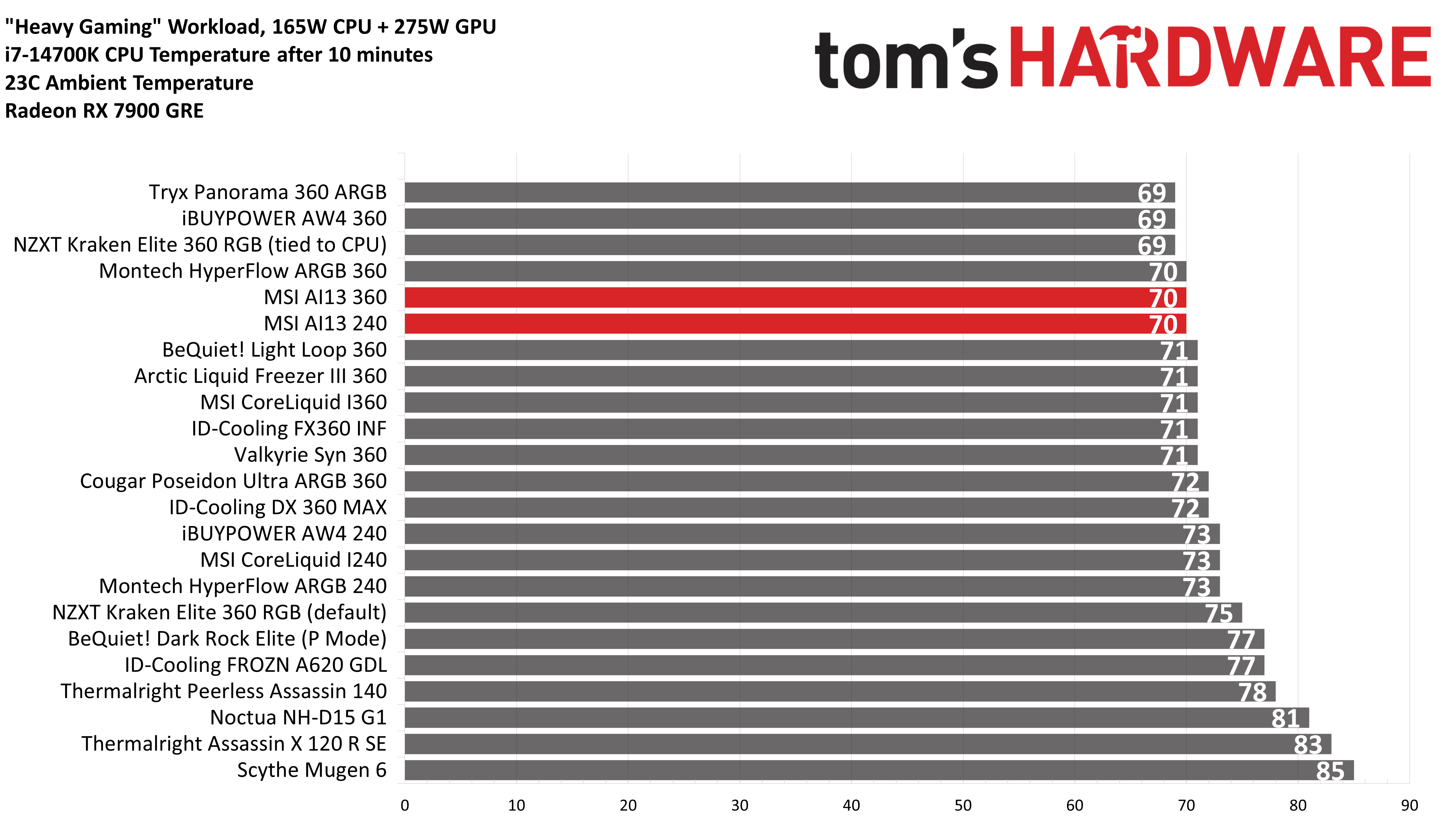
The 360mm and 240mm AIOs provided the exact same thermal performance in this “heavy gaming” scenario, tied with Montech’s Hyperflow 360 for the second-best thermal results here.
Noise levels weren’t bad either, with 40.9 & 41.4 dBA readings. While these don’t take the best spots for noise levels, they certainly run quieter than most other coolers I’ve run through this test.
135W CPU + 290W GPU results
Our second round of CPU + GPU testing is performed with Arrow Lake. The power limit of 135W was chosen based on the worst CPU power consumption I observed in gaming, which was in Rise of the Tomb Raider.
This scenario isn’t quite as thermally demanding as our previous results, and as a result the thermal differences between coolers are smaller. The 240mm A13 performs just a hair better than the best air coolers, and the 360mm version is slightly behind our best results in this scenario.
Noise levels are again more important here. With the 360mm version reaching 40.9 dBA, this isn’t a noisy result by any understanding of the word – but it is louder than competitors from BeQuiet, ID-Cooling, and others.
85W CPU + 290W GPU results
Our third round of CPU + GPU testing is also performed with Arrow Lake. The power limit of 85W was chosen based on typical power consumption in gaming scenarios using the Core Ultra 9 285K CPU. This should be fairly easy for most coolers. The main point of this test is to see how quietly (or loudly!) a cooler runs in low-intensity scenarios.
In terms of thermals, both MSI A13 AIOs performed excellently at 53 & 54 degrees C. But honestly, thermals in this type of scenario really don’t matter – especially when the most basic of air coolers is managing to keep the CPU under 60 degrees C. Noise matters much more here.
Like the previous set of noise results, the measurements here are not loud by any stretch of the word, but the coolers do run louder than the competitors I’ve measured.
Conclusion
MSI’s A13 AIOs provide good overall thermal performance and noise levels. These aren’t the strongest or quietest AIOs on the market, but they’re not far from it – and the U.S. price tags of $79 for the 240mm and $99 for the 360mm version are very reasonable.

Albert Thomas is a contributor for Tom’s Hardware, primarily covering CPU cooling reviews.
-
thestryker Seems like the only reason to get the 240 would be the benefit of moving CPU heat to another location in the case. Otherwise save the $40 and get the Thermalright PA 140.Reply
Speaking of Thermalright the Royal Pretor 130 Black is up on Amazon now though two week delivery time. I thought they were doing offset pipes on all the new coolers, but it looks like it's only the Royal Knight (which is also available now, but I think from a cooling perspective is the less interesting one). The Pretor has 28mm thick fans 120mm front and 130mm middle whereas the Knight uses 15mm thick front and 28mm middle (120mm both).
Thermalright has singlehandedly made cooling far more interesting than it had been in many years. -
PixelAkami If possible can you guys try one of the Geometric Future AIOs? If what their specs are saying are true, they could be a good alternative to the mainstream coolers too.Reply -
YSCCC Reply
actually TR also make AIO stupidly affordable, using their frozen edge 360 costing some $54 to replace the Noctua NH-U12A, works crazy good for the 14900k, it's as cheap as to I am willing to gamble on potential gunking up AIO due to unknown liquid used and corrosionthestryker said:Seems like the only reason to get the 240 would be the benefit of moving CPU heat to another location in the case. Otherwise save the $40 and get the Thermalright PA 140.
Speaking of Thermalright the Royal Pretor 130 Black is up on Amazon now though two week delivery time. I thought they were doing offset pipes on all the new coolers, but it looks like it's only the Royal Knight (which is also available now, but I think from a cooling perspective is the less interesting one). The Pretor has 28mm thick fans 120mm front and 130mm middle whereas the Knight uses 15mm thick front and 28mm middle (120mm both).
Thermalright has singlehandedly made cooling far more interesting than it had been in many years. -
Albert.Thomas Reply
I was trying to decide on what product to test next.thestryker said:Thermalright has singlehandedly made cooling far more interesting than it had been in many years.
Since everyone loves Thermalright, I think I'll do the Grand Vision 360 next ;) -
Albert.Thomas Reply
They sent me this one in the past:PixelAkami said:If possible can you guys try one of the Geometric Future AIOs? If what their specs are saying are true, they could be a good alternative to the mainstream coolers too.
https://www.tomshardware.com/pc-components/liquid-cooling/geometric-future-eskimo-junior-24-review -
YSCCC Reply
just FYI, in my case a under volted 14900k with NH-U12A full fan only able to keep it peak at 98-100C in 24C ambient in R23, changing to the forzen edge 360 makes R23 peaks at 81C. What is concerning for TR is that they are made so cheap, and they are the new OEM, wondering will it gunk up like the previous apeltek MSI AIOs or it's really a crazy good budget champAlbert.Thomas said:I was trying to decide on what product to test next.
Since everyone loves Thermalright, I think I'll do the Grand Vision 360 next ;) -
thestryker Reply
This has been on my mind with regards to their AIOs as well. They do have a good warranty period, but I've never had to use a warranty with them so I don't know how simple that is (more of an e-waste concern than replacement cost personally).YSCCC said:What is concerning for TR is that they are made so cheap, and they are the new OEM, wondering will it gunk up like the previous apeltek MSI AIOs or it's really a crazy good budget champ
They also release a lot of AIOs similar to what they do with air coolers which makes me wonder how many pump designs they have. Only the most recent models list more pump details and from that I could see the Frozen Warframe, Aqua Elite and Hyper/Grand Vision each use a different pump. Grand and Hyper using the same makes me hope that perhaps it's the same pump within each model lineup, but impossible to say.
Looks like that's using one of the new 28mm thick fan designs. Of course this also made me look up the Vision AIO line and see there's Grand, Hyper, Elite, Mjolnir, Core and Frozen models.Albert.Thomas said:I think I'll do the Grand Vision 360 next ;) -
YSCCC Reply
For me I am less concerned about the pump as long as it functions, usually it's air bubbles or constant spooling of the pump killing it, I tend to use AIOs with fixed 75% pump actually runs quieter and performs better than PWM ones spooling with heatthestryker said:This has been on my mind with regards to their AIOs as well. They do have a good warranty period, but I've never had to use a warranty with them so I don't know how simple that is (more of an e-waste concern than replacement cost personally).
They also release a lot of AIOs similar to what they do with air coolers which makes me wonder how many pump designs they have. Only the most recent models list more pump details and from that I could see the Frozen Warframe, Aqua Elite and Hyper/Grand Vision each use a different pump. Grand and Hyper using the same makes me hope that perhaps it's the same pump within each model lineup, but impossible to say.
Looks like that's using one of the new 28mm thick fan designs. Of course this also made me look up the Vision AIO line and see there's Grand, Hyper, Elite, Mjolnir, Core and Frozen models.
But gunking/galvanic corrosion is what I am a bit wery of. but bite the bullet as it only cost $53, first way into AIO. If it ever fails prematurely, seeing the temp benefit I might change to Bequiet partly due to their refillable design. -
Phaaze88 Reply
Galvanic corrosion is par the course with mixed metal AIOs(copper cold plate, aluminum radiator). Full-copper avoids this, but costs more; Alphacool has been like the only one doing all copper AIOs.YSCCC said:But gunking/galvanic corrosion is what I am a bit wery of.
There's biocide and corrosion inhibitor within the premixed fluid, though they only last so long...
The Thermalright coolers are very affordable. Can't hurt to give 'em a shot. -
YSCCC Reply
This, is precisely why I gave it a shot, even if it only works for a few months (finger crossed) is kind of fine for $53. but really, most AIOs have used the inhibitor so successfully that essentially eliminates the corrosion, hopefully with TR they can do the samePhaaze88 said:Galvanic corrosion is par the course with mixed metal AIOs(copper cold plate, aluminum radiator). Full-copper avoids this, but costs more; Alphacool has been like the only one doing all copper AIOs.
There's biocide and corrosion inhibitor within the premixed fluid, though they only last so long...
The Thermalright coolers are very affordable. Can't hurt to give 'em a shot.



